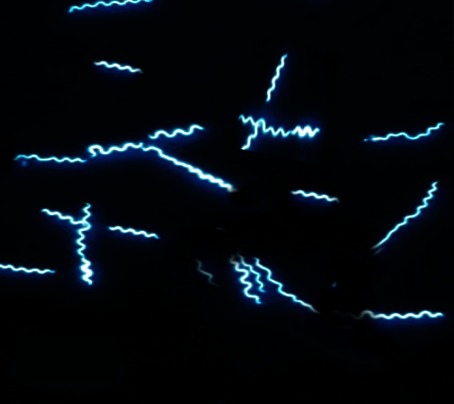Lyme disease Pathenogenisis: Difference between revisions
No edit summary |
No edit summary |
||
| Line 1: | Line 1: | ||
<!-- Do not edit this line-->{{Curated}} | <!-- Do not edit this line-->{{Curated}} | ||
==Introduction== | ==Introduction== | ||
[[Image:B. burgdorferi.jpg|thumb|600px|right|]] | [[Image:B. burgdorferi.jpg|thumb|600px|right|This is a photo of <i>Borrelia burgdorferi</I> obtained through the use of dark field microscopy. By S. Bhimji MD. [https://www.ncbi.nlm.nih.gov/books/NBK532894/figure/article-18460.image.f1/]. ]] | ||
<br>By Jp Timken<br> | <br>By Jp Timken<br> | ||
Revision as of 21:30, 13 April 2022
Introduction

By Jp Timken
Lyme disease is a vector-borne illness caused by a spirochete known as Borrelia burgdorferi. It has serious side effects and can lead to issues with the heart, brain, and spinal cord. Transmission occurs through certain species of ticks, and takes several days. Removal of the tick before 36 hours can reduce chances of infection. As such, it is typically transmitted through younger, smaller ticks that can go undetected for longer periods of time. The name comes from the point of discovery, which was Lyme, Connecticut in the 1970s. In spite of this, the disease is thought to have been around since the early 20th century.
B. burgdorferi consists of a long body that may appear wavy or curled. The genome consists of a linear chromosome and many plasmids. The expression of these genes changes based on the host species. So, the genes expressed while in a tick will vary from those expressed after transmission to a different host organism.
Lyme disease can be treated through various antibiotics. Symptoms will typically subside once treatment is administered, though they can persist in some cases. For more serious cases, intravenous antibiotics may be necessary, but if it is caught early, oral antibiotics may be prescribed by a doctor to prevent serious infection. A lot about treatment is still unknown.
At right is a sample image insertion. It works for any image uploaded anywhere to MicrobeWiki.
The insertion code consists of:
Double brackets: [[
Filename: PHIL_1181_lores.jpg
Thumbnail status: |thumb|
Pixel size: |300px|
Placement on page: |right|
Legend/credit: Electron micrograph of the Ebola Zaire virus. This was the first photo ever taken of the virus, on 10/13/1976. By Dr. F.A. Murphy, now at U.C. Davis, then at the CDC. Every image requires a link to the source.
Closed double brackets: ]]
Other examples:
Bold
Italic
Subscript: H2O
Superscript: Fe3+
Sample citations: [1]
[2]
A citation code consists of a hyperlinked reference within "ref" begin and end codes.
To repeat the citation for other statements, the reference needs to have a names: "<ref name=aa>"
The repeated citation works like this, with a forward slash.[1]
Borrelia burgdorferi
Include some current research, with at least one figure showing data.
Every point of information REQUIRES CITATION using the citation tool shown above.
Transmission
Ticks that carry B. burgdorferi are able to transmit Lyme disease to many different organisms. Two types of ticks can carry and transmit the microbe, and they are both blacklegged ticks. One type, the blacklegged tick, is prevalent throughout the majority of the United States and is responsible for transmission on the Atlantic Coast, in the northeast, and in the central U.S. The other, the western blacklegged tick, is responsible for spreading the microbe throughout the western U.S. Ticks have multiple stages in their life cycle. They start as larva, then grow to nymphs, and then adults. Most transmissions are caused by nymphs, as the tick must be attached for more than 36 hours for transmission to occur. Because the nymphs are quite small compared to the adult ticks, they can be more hidden and stay attached long enough for transmission to occur. Lyme disease can’t be passed from person to person through any type of contact. For infection to occur, one must have been bitten by a tick carrying the microbe. In very rare cases, it can be passed from mother to child if an expecting mother is not undergoing any treatment but is infected. When feeding, the tick passes its own saliva to the host, which is when B. burgdorferi is transmitted. When the tick first begins to feed on the host, the spirochete begins to rapidly reproduce in the gut of the tick, preparing for transmission. The tick has the ability to change the chemical composition of the saliva to damage the host immune system and response. The saliva is very important for B. burgdorferi to be transmitted from the tick to the host.
The symptoms of Lyme disease can vary. Often, a rash occurs shortly after transmission. The rash is circular, centering around the bite and expanding out over the course of several days. In rare cases, it may cause pain or itchiness, but it typically won’t cause any type of discomfort. In the case that a rash doesn’t appear, other beginning symptoms might take its place, such as aches, fatigue, fever, headache, or chills. These symptoms and the rash typically won’t occur together. After the initial infection period, which lasts anywhere from 3-30 days, additional symptoms may occur. The main symptom is joint and muscle pain or stiffness. Swelling of the joints can also occur, and more rashes can appear on other parts of the body. This disease can be very dangerous and cause complications with the heart, spinal cord, and even brain.
Immune Response
Include some current research, with at least one figure showing data.
Treatment
Conclusion
References
Authored for BIOL 238 Microbiology, taught by Joan Slonczewski, 2022, Kenyon College
